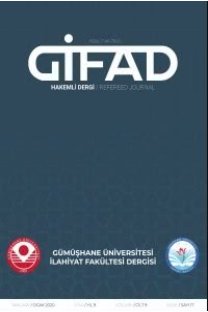TÜRK GAZETELERİNDE DARBE HABERLERİNİN ELEŞTİREL SÖYLEM ÇÖZÜMLEMESİ
Bu makale dört ulusal gazetede, darbeler açısından yakın Türkiye tarihinin iki önemli olayının (28 Şubat 1997 MGK Toplantısı ve Adalet ve Kalkınma Partisi’ne 2008’de açılan kapatma davası) ele alınış biçimlerini incelemektedir. Bu minvalde, makalenin amacı gazetelerin bu iki önemli olaydaki rollerini anlamaya çalışmaktır. Bu nedenle ilk olarak söz konusu sosyal sorunnun ve olayların arka planı açıklanacaktır. Konuyla ilgili haberlerden ve haber görsellerinden oluşan veri öncelikle dijital ortama aktarılarak bir derlem elde edilmiştir. Elde edilen derlem Eleştirel Söylem Çözümlemesinin önemli bir kolu olan Tarihi Söylem Yaklaşımı kullanılarak çözümlenmiştir. İnceleme sonuçları her bir gazetenin kelime seçiminin ve söylem oluşturma şeklinin, gazetenin söz konusu olaya yönelik genel yaklaşımından bağımsız olmadığı saptanmıştır. Sonuç olarak gazetelerin, özellikle 28 Şubat sürecinde, söz konusu sorunun güçlü gruplar tarafından yapılan tanımına kafa tutamayacak kadar kadar uysal oldukları gözlemlenmiştir. Daha önemlisi, çatışmanın iki farklı dünya görüşü arasında olduu kadar aynı dinin Türkiye’deki farklı algılanışları arasında cereyan ettiği görülmektedir
Anahtar Kelimeler:
Türk gazeteleri, Türkiye, darbe, eleştirel söylem çözümlemesi, söylem tarihi yaklaşımı
CRITICAL DISCOURSE ANALYSIS OF DISCOURSES ON AND AROUND COUP D’ÉTAT IN TURKISH NEWSPAPERS
This article seeks to critically analyse the discourse(s) of four Turkish dailies (Cumhuriyet, Hürriyet, Vakit and Zaman) on two significant political events, the National Security Council meeting on 28th February 1997 and the 2008 indictment case against the ruling Justice and Development Party, with a special focus on the recent 15th July 2016 coup attempt in the discussion. By doing so, the objective will be to understand the coverage of coup d’état by each newspaper. The historical significance of the social problem at stake, and the context of the events, will be delineated at the outset. The data consisting of images of pertinent news articles are digitalised and assembled into a corpus. The news corpus is analysed drawing on a specific Critical Discourse Analysis approach, namely the Discourse-Historical Approach. The findings have shown that the lexical selection and discourse formation of each newspaper is not independent of the agency’s attitude towards the events in question. As a result, the newspapers are found to be too acquiescent to challenge the definition of the problem independent of the powerful groups, particularly within the context of 28 February process. More importantly, the conflict seems to rage not in between two separate ideologies but over different understandings of the same religion, i.e. Islam.
Keywords:
Turkish newspapers, Turkey, coup d’état, critical discourse analysis, discourse historical approach,
___
- Al-Hejin, B. (2015). Representation of Muslim Women in the BBC and Arab News. (PhD), Lancaster University, Lancaster.
- Cizre, Ü., & Çınar, M. (2003). Turkey 2002: Kemalism, Islamism, and Politics in the Light of the February 28 Process South Atlantic Quarterly (Vol. 102, pp. 309-332): Duke University Press.
- Entman, R. M. (2004). Projections of Power: framing news, public opinion, and U.S. foreign policy. Chicago, London: The University of Chicago Press.
- Fairclough, N. (1995). Media Discourse. London: Arnold.
- Fiske, J. (1990). Introduction to Communication Studies (Second ed.). London: Routledge.
- Göle, N. (1996). The forbidden modern : civilization and veiling Ann Arbor, Mich. : University of Michigan Press.
- Hale, W. M., & Özbudun, E. (2010). Islamism, democracy and liberalism in Turkey : the case of the AKP New York: Routledge.
- Jenkins, G. (2008). Political Islam In Turkey: Running West, Heading East? New York, N.Y.: Palgrave Macmillan.
- Kavakci, M. (2009). Turkey's Test with Its Deep State. Mediterranean Quarterly, 20(4), 83-97.
- Marsden, L. & Savigny, H. (2009). Media, Religion and Conflict. Surrey: Ashgate.
- Meyer, J. H. (1998). Politics as usual: Ciller, Refah and Susurluk: Turkey's troubled democracy. East European Quarterly, 32(4), 489.
- Pak, S.-Y. (2004). Articulating the Boundary between Secularism and Islamism: The Imam-Hatip Schools of Turkey. Anthropology & Education Quarterly, 35(3), 324-344. doi: 10.1525/aeq.2004.35.3.324
- Phillips, L., & Jorgensen, M. W. (2002). Discourse Analysis as Theory and Method. London: Sage.
- Reisigl, M. (2011). Argumentation Analysis in Critical Discourse Studies. Presented in the Workshop of Language, Ideology and Power Research Group, Lancaster University 20.11.2011.
- Reisigl, M., & Wodak, R. (2001). Discourse and discrimination. Rhethorics of racism and anti-Semitism. London: Routledge.
- Said, E. W. (1979). Orientalism: Vintage Books.
- Saktanber, A., & Çorbacıoğlu, G. (2008). Veiling and Headscarf-Skepticism in Turkey. Social Politics: International Studies in Gender, State and Society, 15(4), 514-538.
- Shively, K. (2008). Taming Islam: Studying Religion in Secular Turkey. Anthropological Quarterly, 81(3), 683-711.
- Tocci, N. (2001). 21st century Kemalism: redefining Turkey-EU relations in the Post-Helsinki era: Centre for European Policy Studies.
- Van Dijk, T. A. (1985). Structures Of News In The Press. In T. A. Van Dijk (Ed.), Discourse And Communication New Approaches To The Analysis Of Mass Media And Communication (Pp. 69-93). Berlin; New York: De Gruyer.
- Van Eemeren, F., Grootendorst, R., & Henkemans, F. S. (1996). Fundamentals of Argumentation Theory A Handbook of Historical Backgrouds and Contemporary Developments. New Jersey: Lawrence Erlbaum Associates.
- Wodak, R. (1990). The Waldheim affair and antisemitic prejudice in Austrian public discourse. Patterns of Prejudice, 24(2-4), 18-33. doi: 10.1080/0031322x.1990.9970049
- Wodak, R., Cillia, R. d., Reisigl, M., & Liebhart, K. (2009). The Discursive Construction of National Identity (2nd ed.). Edinburgh: Edinburgh University Press Wodak, R., & Pelinka, A. (Eds.). (2002). The Haider Phenomenon in Austria. New Brunswick, New Jersey: Transaction
- ISSN: 2146-3301
- Yayın Aralığı: Yılda 2 Sayı
- Başlangıç: 2011
- Yayıncı: Mustafa Cankut
Sayıdaki Diğer Makaleler
İSLAMİ İNANÇ DESTİNASYONLARININ TANITIMINDA YOUTUBE VİDEOLARININ KULLANIMI
Salih GÜRBÜZ, Bayram Oğuz AYDIN
TÜRK BASININDA LİDERLERİN 16 MAYIS 2017 REFERANDUM HABERLERİNİN ÇERÇEVELENMESİ
AİLE HEKİMLERİNİN İNTERNET VE SOSYAL MEDYA KULLANIM ÖZELLİKLERİNİN İNCELENMESİ
KURUMSAL SOSYAL SORUMLULUK İLETİŞİMİ VE HALKLA İLİŞKİLER
İTİBAR YÖNETİMİ VE ÖZEL SAĞLIK KURUMLARINA YÖNELİK BİR UYGULAMA
ÜNİVERSİTE GENÇLİĞİ BAĞLAMINDA SİYASAL KATILIM VE KİŞİLİK ÖZELLİKLERİ ARASINDAKİ İLİŞKİ
Zeynep Nihan BAKIR, Gülten ADALI AYDIN, Murat BİROL
“KAŞAĞI” ADLI HİKÂYENİN AİLE İÇİ İLETİŞİM VE İLETİŞİM ÇATIŞMALARI AÇISINDAN İNCELENMESİ
